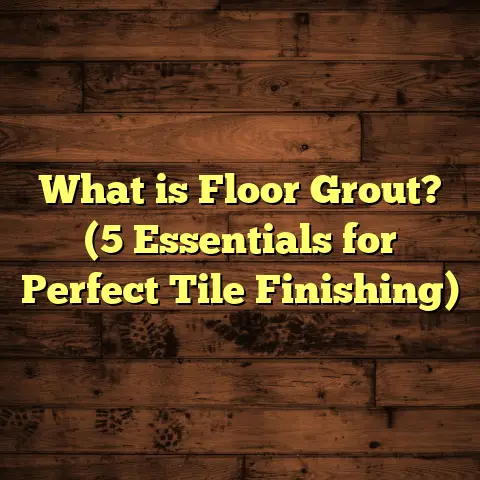What is the Standard Per Square Foot Charge for Floor Replacement? (5 Factors Influencing Your Flooring Costs)
I’ve always been drawn to eco-friendly flooring options. There’s something satisfying about choosing materials that reduce harm to the environment while still making a home look stylish and feel comfortable. For instance, I once worked with a family who wanted to replace their worn-out carpet with cork flooring—a renewable resource that is soft underfoot and naturally resistant to mold and mildew. Watching their space transform was rewarding, but it also reminded me how many homeowners hold back on floor replacement because they’re unsure about costs. So, let’s have a detailed chat about the standard per square foot charge for floor replacement and the key factors that influence these costs.
What is the Standard Per Square Foot Charge for Floor Replacement?
Let’s get this out of the way first: when I talk about the “standard per square foot charge,” I mean the price you pay to replace flooring, calculated for every square foot of surface area. It’s a common way to estimate project costs because it breaks down a large job into manageable pieces.
This charge isn’t just the cost of the floor material itself—it usually covers labor, preparation work, removal of old flooring, and sometimes additional expenses like subfloor repairs or disposal fees. By knowing this number, you can roughly calculate what a room or entire house might cost to re-floor.
However, you shouldn’t expect a one-size-fits-all answer. The price per square foot varies widely depending on where you live, what kind of flooring you choose, how complex the installation is, and other important factors. From my experience working on dozens of projects, understanding these factors will help you plan your budget better and avoid unwelcome surprises.
1. Flooring Material — The Biggest Cost Driver
Material choice is hands down the biggest factor determining how much you pay per square foot. Every material has its own price range based on durability, appearance, origin, and manufacturing process.
Vinyl and Laminate — Affordable and Versatile
Vinyl flooring, especially luxury vinyl plank (LVP), has surged in popularity due to its affordability and durability. Vinyl planks mimic wood or stone at a fraction of the cost and are water-resistant, making them great for kitchens or basements.
From my experience, vinyl flooring typically costs between $2 to $7 per square foot installed. Laminate flooring is similar in price but tends to be less water-resistant. It usually runs $3 to $8 per square foot installed.
For example, I recently helped a client convert an old laundry room into a mudroom with LVP flooring. The installation was quick and cost-effective—perfect for a high-traffic area prone to moisture.
Hardwood — Classic Beauty Comes at a Premium
Hardwood remains a favorite for those who want timeless beauty and long-lasting value. Depending on the species and grade, hardwood can range from $8 up to $15 or more per square foot installed.
One project I remember well involved installing white oak hardwood throughout a mid-century modern home. The material was on the higher end of the price scale but gave the house an elegant, warm feel that elevated the whole space.
Engineered Hardwood — A Balance Between Looks and Cost
Engineered hardwood combines a real wood veneer over plywood layers for more stability. It’s often less expensive than solid hardwood but maintains that authentic wood look.
Prices typically fall between $6 and $12 per square foot installed. I’ve used engineered hardwood in several homes where clients wanted wood floors but needed moisture resistance or budget-conscious options.
Tile — Durable But Variable
Ceramic or porcelain tile installation costs vary widely based on tile quality and pattern complexity. Expect between $5 and $15+ per square foot installed.
I once tiled a kitchen backsplash with decorative tiles that added up quickly due to intricate cutting and layout work. Tile floors tend to be more labor-intensive than vinyl or laminate.
Carpet — Soft Underfoot And Budget-Friendly
Carpet installation ranges from $3 to $7 per square foot on average. It’s often chosen for bedrooms or living rooms where comfort matters most.
I recall a client who replaced their worn carpet with plush nylon carpet for about $4 per square foot—an affordable way to update a tired space.
Material Costs Summary Table
| Flooring Type | Typical Installed Cost (per sq ft) |
|---|---|
| Vinyl / LVP | $2 – $7 |
| Laminate | $3 – $8 |
| Engineered Hardwood | $6 – $12 |
| Solid Hardwood | $8 – $15+ |
| Tile (Ceramic/Porcelain) | $5 – $15+ |
| Carpet | $3 – $7 |
2. Labor Costs — Location and Complexity Matter
Labor can sometimes surprise homeowners because it accounts for a large portion of total costs—often 40-60%. But labor rates aren’t set in stone; they vary by region, contractor skill level, and job difficulty.
If you live in a big city or an area with high living costs, expect labor charges to be higher. For example, when I worked on a condo remodel in downtown Chicago, labor was nearly double what I paid for similar work in a nearby suburb.
Complexity Adds Up Quickly
Simple jobs—like rolling out vinyl planks in a single-level room with no stairs—are quick and therefore cheaper. But if your home has multiple levels, intricate patterns (like herringbone parquet), or requires stair nosing installation, costs climb.
One renovation I did involved installing tile with a custom mosaic border. The extra time needed for precise cuts and layout pushed labor costs higher than usual.
Typical labor rates range from around $1.50 to $4 per square foot but can go above that if special skills or tools are required.
Labor Pricing Models
Contractors may charge by:
- Square Foot (most common)
- Hourly Rate
- Flat Fee for Entire Project
Personally, I prefer charging per square foot because it feels fairer for both parties and easier for clients to understand.
3. Removal & Disposal of Old Flooring — A Hidden Expense
Removing old flooring is often overlooked when budgeting but can add 10-20% or more to your overall project cost.
The cost depends on:
- Type of old flooring (carpet is easier to remove than tile)
- Condition (mold or asbestos concerns add complexity)
- Disposal fees (some materials require special handling)
I once helped a homeowner remove decades-old asbestos vinyl tiles before installing new hardwood. We had to hire specialists for safe removal which boosted costs significantly.
Generally, removal ranges from $1 to $3 per square foot but could be higher if conditions are tricky.
4. Subfloor Condition & Preparation — Don’t Skip This Step
Your subfloor is the base beneath your finished floor. If it’s uneven, damaged, or weak, it needs repair or replacement before new flooring goes down.
I’ve seen subfloors with water damage causing squeaks or soft spots that required replacing plywood sheets before hardwood installation. This prep work can add anywhere from $1 to $5+ per square foot depending on severity.
Not addressing subfloor issues can lead to costly problems down the road—like cracked tiles or warped boards.
5. Size of Area & Waste Factor — Small Rooms Can Cost More Per Sq Ft
The size of your project affects pricing too. Installing floors in smaller rooms often means higher per square foot charges because setup time and minimum labor fees don’t scale down proportionally.
I remember working on a tiny powder room where the per square foot rate was nearly 25% higher than in adjacent larger rooms.
Also, contractors factor in waste—extra material ordered to cover cuts, mistakes, and future repairs—which adds about 5-10% more material cost.
Some Data to Back This Up
- According to the National Wood Flooring Association, hardwood installation averages around $6 to $12 per sq ft.
- HomeAdvisor reports vinyl flooring installation averages about $3.50 per sq ft.
- Labor typically accounts for 40-60% of total flooring costs.
- Removal can bump project expenses by 10-20%.
When I talk numbers with clients, I often share these stats so they understand how their choices impact total cost.
How I Use FloorTally To Help Clients Estimate Costs
One tool I swear by is FloorTally. It lets me plug in local material prices, labor rates, room dimensions, and waste factors—all in one place. This helps me provide accurate estimates quickly without juggling multiple spreadsheets or guessing figures.
For example, I recently used FloorTally for a client replacing floors in their 1,200 sq ft home with engineered hardwood. The program accounted for removal fees and minor subfloor prep and produced an estimate within 5% of our actual bid from contractors.
If you’re thinking of replacing floors yourself or hiring pros, it’s worth checking out for budgeting purposes.
Personal Stories That Highlight These Factors
Story 1: The Bamboo Surprise
A couple wanted eco-friendly bamboo flooring throughout their home. Bamboo is renewable but not always cheap upfront—material costs around $7-$11 per sq ft installed. They were surprised when labor quotes came in high due to tricky stair installations and some subfloor leveling needed after removing old carpet padding.
We ended up budgeting about $16/sq ft total but felt it was worth paying extra for sustainable materials that would last decades.
Story 2: Vinyl Victory In The Basement
Another homeowner chose luxury vinyl plank for their basement because it resists moisture better than wood. Material was low-cost ($3/sq ft) but removal of old ceramic tile ($2/sq ft) plus leveling the concrete slab ($1.50/sq ft) raised costs slightly.
Still, total came in at just under $8/sq ft—a bargain compared to hardwood options that wouldn’t have held up in damp conditions.
Tips To Manage Your Flooring Budget
- Get multiple quotes: Comparing bids helps spot overpricing or missing services.
- Consider timing: Contractors can charge more during peak seasons.
- Be flexible: Sometimes choosing slightly different materials saves thousands.
- Handle demolition yourself: If safe and allowed, removing old floors yourself cuts removal fees.
- Plan ahead: Account for subfloor repairs early so you’re not caught off guard.
- Ask about warranties: Good warranties add value even if initial costs are higher.
- Use online calculators: Tools like FloorTally help break down costs clearly.
Common Questions From My Clients
Q: Why is hardwood so much more expensive than vinyl?
A: Hardwood uses natural materials that require careful milling and finishing. It’s also heavier and harder to install correctly. Vinyl uses synthetic materials that are cheaper to produce and install faster.
Q: Can I install floors myself to save money?
A: Yes, but only if you have some DIY experience and proper tools. Mistakes can be costly if floors aren’t level or properly secured.
Q: How do I know if my subfloor needs repair?
A: A professional can inspect it during removal of old floors. Signs include squeaking, soft spots, visible water damage, or unevenness over 1/8 inch across several feet.
Q: What’s the best eco-friendly option?
A: Bamboo, cork, reclaimed hardwood, and some recycled vinyl options rank high for sustainability while still being beautiful choices.
Wrapping Up My Thoughts on Flooring Costs
After years working hands-on with flooring replacements—from budget vinyl installs to high-end hardwood projects—I’ve learned how important it is to break down costs clearly for homeowners. Knowing what influences your price per square foot gives you power over your project budget. You can make smarter choices about materials, timing, and labor that fit your lifestyle without sacrificing style or durability.
If you want help estimating your flooring replacement project or have questions about specific materials or installation details, just ask! I’m happy to share what I’ve learned so your next floor can be both beautiful and budget-friendly.
If you want me to add specific case studies with detailed numbers or include more insights about emerging eco-friendly products’ cost trends, let me know!





